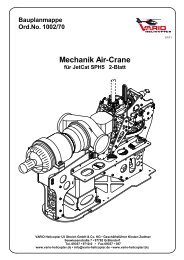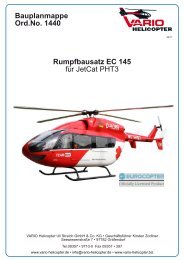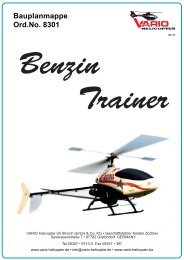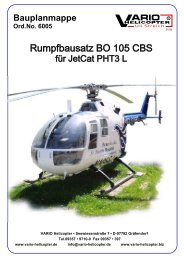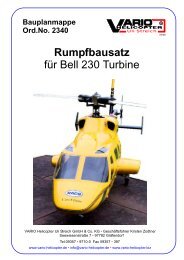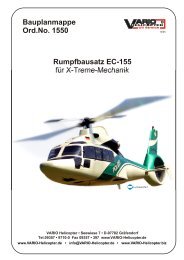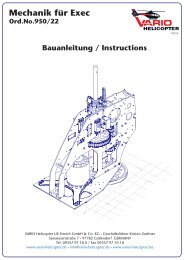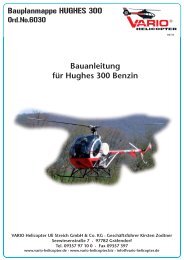Bauplanmappe Ord.No. 1002/71 Mechanik Air ... - Vario Helicopter
Bauplanmappe Ord.No. 1002/71 Mechanik Air ... - Vario Helicopter
Bauplanmappe Ord.No. 1002/71 Mechanik Air ... - Vario Helicopter
You also want an ePaper? Increase the reach of your titles
YUMPU automatically turns print PDFs into web optimized ePapers that Google loves.
� Sofort bedeutet innerhalb der ersten Sekunde.<br />
� Trainieren Sie vorab gedanklich, w as Sie in besonderen Situationen tun müssen.<br />
� Sollte in Ihrem Modell w iederholt ein gleicher technischer Defekt auftreten so w ird der erneute<br />
Austausch der Komponente nicht die Lösung sein solange sich an den Betriebsbedingungen<br />
nichts ändert.<br />
� Eine Bitte noch zum Abschluß:<br />
Schätzen Sie Ihre fliegerischen Fähigkeiten realistisch ein. Dazu paßt folgender Vergleich: Wer<br />
nicht schw immen kann und trotzdem ins tiefe Wasser geht, w ird voraussichtlich ertrinken.<br />
Operating a model helicopter for the first time<br />
Even if you already know „all there is to know " about model helicopters please read the follow ing<br />
notes carefully:<br />
Before operating the model check the follow ing points:<br />
- The direction of servo rotation (including the throttle function) and travels.<br />
- The direction of effect of the gyro, and the transmitter mixer functions you have programmed.<br />
- Collective pitch travel (linear travel -2/-3° to +9/+10°); rotor diameter 2000 mm Ø plus: 0° to +10°<br />
- It is permissible to reduce servo travels, but not below 60% (in this case adjust the mechanical<br />
linkage); travels should be primarily symmetrical.<br />
- Apply collective pitch min. / collective pitch max. and full roll and pitch-axis commands<br />
simultaneously in all directions; rotate the rotor head at the same time, and check that at the<br />
extremes of travel no part of the rotor head is obstructed, and the collective pitch compensator<br />
guide pin does not foul the sw ashplate.<br />
- Check the safe connection of the ball link of the sw ashplate driver before each flight, if the rotor<br />
head is using one.<br />
- The auto-rotation sw itch must be assigned, and w ithin easy reach!<br />
- When auto-rotation is selected: throttle position to off, all directions of control and travels as in<br />
normal flight, tail rotor to 0° = fixed value.<br />
- Do not set the tail rotor gyro to w ork in „heading-lock mode" initially.<br />
- Contrary to the information supplied by many gyro manufacturers, the greater inertia of larger<br />
helicopters means that they do need the support of tail rotor mixer functions in normal mode.<br />
- Tail rotor position 0° at collective pitch min.; at collective pitch max. the tail rotor blade tips should<br />
be about 50 - 60 mm apart w hen the blades are folded together in the blade holders.<br />
- Set the motor distinctly „rich", and set the throttle curve very low: the throttle curve should then be<br />
raised gradually in s mall increments, and the motor cautiously „leaned out" until the correct rotor<br />
speed level is reached; i.e. w ork „upw ards" towards the correct speed!<br />
- The first few tankfuls should be flow n w ith the model close to the ground, i.e. no more than about 1<br />
m altitude, until you are confident that there are no defects or errors, and that everything is w orking<br />
faultlessly:<br />
- Use your ears critically (!), listening for unusual sounds and vibration, and seek out the problem if<br />
you are in any doubt at all!<br />
- Don’t listen to anyone standing close by if they try to hurry you into flying the model.<br />
- Avoid hovering outside ground effect (hover altitude w ith a model: approx. 1 m, or half the rotor<br />
disc diameter):<br />
- Hovering requires very high pow er, and you are completely dependent on the motor: in contrast to<br />
most full-size helicopters, model helicopters have only one (!) pow er plant.



